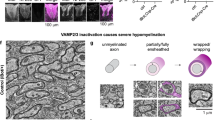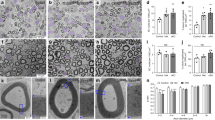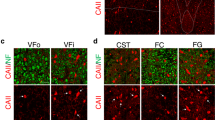Abstract
Axonal maturation and myelination are essential processes for establishing an efficient neuronal signaling network. We found that nardilysin (N-arginine dibasic convertase, also known as Nrd1 and NRDc), a metalloendopeptidase enhancer of protein ectodomain shedding, is a critical regulator of these processes. Nrd1−/− mice had smaller brains and a thin cerebral cortex, in which there were less myelinated fibers with thinner myelin sheaths and smaller axon diameters. We also found hypomyelination in the peripheral nervous system (PNS) of Nrd1−/− mice. Neuron-specific overexpression of NRDc induced hypermyelination, indicating that the level of neuronal NRDc regulates myelin thickness. Consistent with these findings, Nrd1−/− mice had impaired motor activities and cognitive deficits. Furthermore, NRDc enhanced ectodomain shedding of neuregulin1 (NRG1), which is a master regulator of myelination in the PNS. On the basis of these data, we propose that NRDc regulates axonal maturation and myelination in the CNS and PNS, in part, through the modulation of NRG1 shedding.
This is a preview of subscription content, access via your institution
Access options
Subscribe to this journal
Receive 12 print issues and online access
$209.00 per year
only $17.42 per issue
Buy this article
- Purchase on Springer Link
- Instant access to full article PDF
Prices may be subject to local taxes which are calculated during checkout








Similar content being viewed by others
Accession codes
References
Nave, K.A. & Trapp, B.D. Axon-glial signaling and the glial support of axon function. Annu. Rev. Neurosci. 31, 535–561 (2008).
Simons, M. & Trotter, J. Wrapping it up: the cell biology of myelination. Curr. Opin. Neurobiol. 17, 533–540 (2007).
Hartline, D.K. & Colman, D.R. Rapid conduction and the evolution of giant axons and myelinated fibers. Curr. Biol. 17, R29–R35 (2007).
McTigue, D.M. & Tripathi, R.B. The life, death, and replacement of oligodendrocytes in the adult CNS. J. Neurochem. 107, 1–19 (2008).
Griffiths, I. et al. Axonal swellings and degeneration in mice lacking the major proteolipid of myelin. Science 280, 1610–1613 (1998).
Lappe-Siefke, C. et al. Disruption of Cnp1 uncouples oligodendroglial functions in axonal support and myelination. Nat. Genet. 33, 366–374 (2003).
Michailov, G.V. et al. Axonal neuregulin-1 regulates myelin sheath thickness. Science 304, 700–703 (2004).
Nave, K.A. & Salzer, J.L. Axonal regulation of myelination by neuregulin 1. Curr. Opin. Neurobiol. 16, 492–500 (2006).
Mei, L. & Xiong, W.C. Neuregulin 1 in neural development, synaptic plasticity and schizophrenia. Nat. Rev. Neurosci. 9, 437–452 (2008).
Falls, D.L. Neuregulins: functions, forms and signaling strategies. Exp. Cell Res. 284, 14–30 (2003).
Montero, J.C., Yuste, L., Diaz-Rodriguez, E., Esparis-Ogando, A. & Pandiella, A. Differential shedding of transmembrane neuregulin isoforms by the tumor necrosis factor alpha–converting enzyme. Mol. Cell. Neurosci. 16, 631–648 (2000).
Shirakabe, K., Wakatsuki, S., Kurisaki, T. & Fujisawa-Sehara, A. Roles of Meltrin beta/ADAM19 in the processing of neuregulin. J. Biol. Chem. 276, 9352–9358 (2001).
Willem, M. et al. Control of peripheral nerve myelination by the beta-secretase BACE1. Science 314, 664–666 (2006).
Hu, X. et al. Bace1 modulates myelination in the central and peripheral nervous system. Nat. Neurosci. 9, 1520–1525 (2006).
Hu, X. et al. Genetic deletion of BACE1 in mice affects remyelination of sciatic nerves. FASEB J. 22, 2970–2980 (2008).
Pierotti, A.R. et al. N-arginine dibasic convertase, a metalloendopeptidase as a prototype of a class of processing enzymes. Proc. Natl. Acad. Sci. USA 91, 6078–6082 (1994).
Chesneau, V. et al. N-arginine dibasic convertase (NRD convertase): a newcomer to the family of processing endopeptidases. An overview. Biochimie 76, 234–240 (1994).
Nishi, E., Prat, A., Hospital, V., Elenius, K. & Klagsbrun, M. N-arginine dibasic convertase is a specific receptor for heparin-binding EGF-like growth factor that mediates cell migration. EMBO J. 20, 3342–3350 (2001).
Nishi, E., Hiraoka, Y., Yoshida, K., Okawa, K. & Kita, T. Nardilysin enhances ectodomain shedding of heparin-binding epidermal growth factor–like growth factor through activation of tumor necrosis factor alpha–converting enzyme. J. Biol. Chem. 281, 31164–31172 (2006).
Hiraoka, Y. et al. Enhancement of alpha-secretase cleavage of amyloid precursor protein by a metalloendopeptidase nardilysin. J. Neurochem. 102, 1595–1605 (2007).
Hiraoka, Y. et al. Ectodomain shedding of TNF-alpha is enhanced by nardilysin via activation of ADAM proteases. Biochem. Biophys. Res. Commun. 370, 154–158 (2008).
Bernstein, H.G. et al. Histochemical evidence for wide expression of the metalloendopeptidase nardilysin in human brain neurons. Neuroscience 146, 1513–1523 (2007).
Lu, Q.R. et al. Common developmental requirement for Olig function indicates a motor neuron/oligodendrocyte connection. Cell 109, 75–86 (2002).
Fields, R.D. & Ellisman, M.H. Axons regenerated through silicone tube splices. II. Functional morphology. Exp. Neurol. 92, 61–74 (1986).
Taveggia, C. et al. Neuregulin-1 type III determines the ensheathment fate of axons. Neuron 47, 681–694 (2005).
Mayford, M., Wang, J., Kandel, E.R. & O'Dell, T.J. CaMKII regulates the frequency-response function of hippocampal synapses for the production of both LTD and LTP. Cell 81, 891–904 (1995).
Dragatsis, I. & Zeitlin, S. CaMKIIalpha-Cre transgene expression and recombination patterns in the mouse brain. Genesis 26, 133–135 (2000).
Yamasaki, N. et al. Alpha-CaMKII deficiency causes immature dentate gyrus, a novel candidate endophenotype of psychiatric disorders. Mol Brain 1, 6 (2008).
Carter, R.J. et al. Characterization of progressive motor deficits in mice transgenic for the human Huntington's disease mutation. J. Neurosci. 19, 3248–3257 (1999).
Takao, K. et al. Impaired long-term memory retention and working memory in sdy mutant mice with a deletion in Dtnbp1, a susceptibility gene for schizophrenia. Mol Brain 1, 11 (2008).
Thinakaran, G. & Koo, E.H. Amyloid precursor protein trafficking, processing and function. J. Biol. Chem. 283, 29615–29619 (2008).
Calaora, V. et al. Neuregulin signaling regulates neural precursor growth and the generation of oligodendrocytes in vitro. J. Neurosci. 21, 4740–4751 (2001).
Wakatsuki, S., Yumoto, N., Komatsu, K., Araki, T. & Sehara-Fujisawa, A. Roles of meltrin-beta/ADAM19 in progression of Schwann cell differentiation and myelination during sciatic nerve regeneration. J. Biol. Chem. 284, 2957–2966 (2009).
Taveggia, C. et al. Type III neuregulin-1 promotes oligodendrocyte myelination. Glia 56, 284–293 (2008).
Brinkmann, B.G. et al. Neuregulin-1/ErbB signaling serves distinct functions in myelination of the peripheral and central nervous system. Neuron 59, 581–595 (2008).
Trapp, B.D. & Nave, K.A. Multiple sclerosis: an immune or neurodegenerative disorder? Annu. Rev. Neurosci. 31, 247–269 (2008).
Yagi, T. et al. A novel ES cell line, TT2, with high germline-differentiating potency. Anal. Biochem. 214, 70–76 (1993).
Todaro, G.J. & Green, H. Quantitative studies of the growth of mouse embryo cells in culture and their development into established lines. J. Cell Biol. 17, 299–313 (1963).
Hospital, V. et al. The metalloendopeptidase nardilysin (NRDc) is potently inhibited by heparin-binding epidermal growth factor–like growth factor (HB-EGF). Biochem. J. 367, 229–238 (2002).
Acknowledgements
We are grateful to N. Nishimoto and H. Nakabayashi for technical assistance, and K. Matsumoto, E. Kimura, A. Kinoshita and A. Sehara for materials. We thank P.W. Park, T. Nishio, H. Fujiwara, T. Kaneko, F. Fujiyama and H. Kawasaki for critical reading of the manuscript. This study was supported by research grants (19041035, 20390255, 20659061, 20200068 and IBR-shien) from the Ministry of Education, Culture, Sports, Science and Technology of Japan. It was also supported by the Takeda Science Foundation, the Mochida Memorial Foundation for Medical and Pharmaceutical Research, the Suzuken Memorial Foundation, the Japan Health Foundation and the Daiichi Sankyo Sponsored Research Program.
Author information
Authors and Affiliations
Contributions
M.O. and E.N. planned the experiments and wrote the manuscript. M.O., Y.H., T.M. and E.N. performed the experiments. H.T. carried out the histological procedures. K.T. and T.M. performed behavioral analysis. N.O. and H.K. generated the Nrd1−/− mice. T. Kimura and T. Kita supervised the work.
Corresponding author
Supplementary information
Supplementary Text and Figures
Supplementary Figures 1–9 (PDF 5569 kb)
Rights and permissions
About this article
Cite this article
Ohno, M., Hiraoka, Y., Matsuoka, T. et al. Nardilysin regulates axonal maturation and myelination in the central and peripheral nervous system. Nat Neurosci 12, 1506–1513 (2009). https://doi.org/10.1038/nn.2438
Received:
Accepted:
Published:
Issue Date:
DOI: https://doi.org/10.1038/nn.2438
This article is cited by
-
Auxiliary roles of nardilysin in the early diagnosis of acute coronary syndrome: a prospective cohort study, the Nardi-ACS study
Internal and Emergency Medicine (2024)
-
Immunohistochemical and clinicopathological study regarding nardilysin on extramammary Paget's disease
Archives of Dermatological Research (2023)
-
Nardilysin in adipocytes regulates UCP1 expression and body temperature homeostasis
Scientific Reports (2022)
-
Cell vibron polariton resonantly self-confined in the myelin sheath of nerve
Nano Research (2020)
-
Early impoverished environment delays the maturation of cerebral cortex
Scientific Reports (2018)



